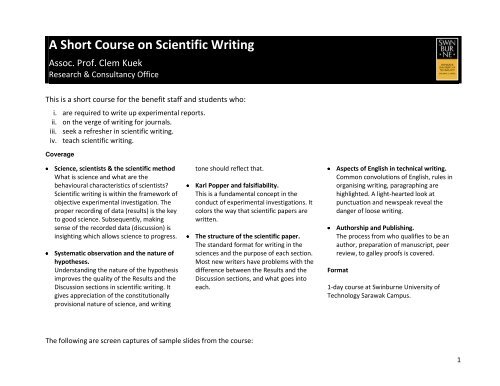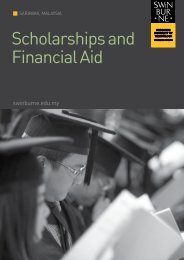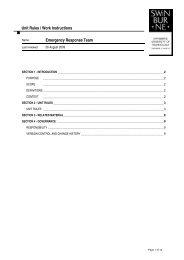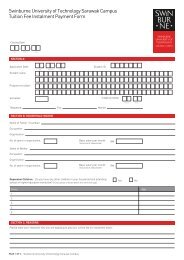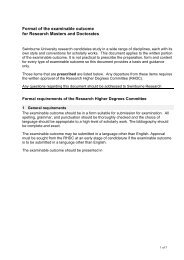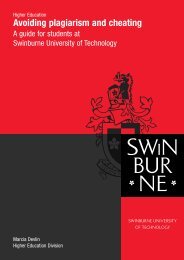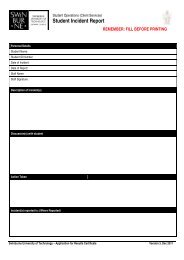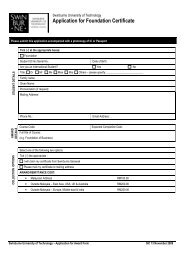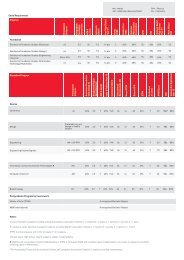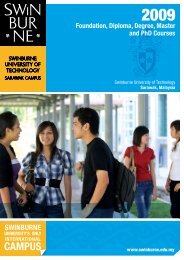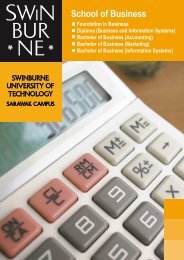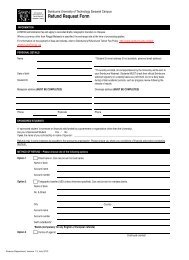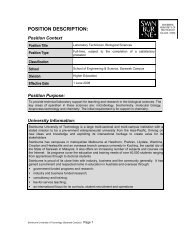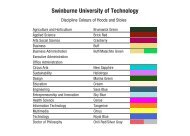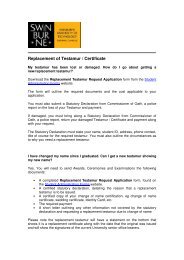A Short Course on Scientific Writing - Swinburne University of ...
A Short Course on Scientific Writing - Swinburne University of ...
A Short Course on Scientific Writing - Swinburne University of ...
Create successful ePaper yourself
Turn your PDF publications into a flip-book with our unique Google optimized e-Paper software.
A <str<strong>on</strong>g>Short</str<strong>on</strong>g> <str<strong>on</strong>g>Course</str<strong>on</strong>g> <strong>on</strong> <strong>Scientific</strong> <strong>Writing</strong><br />
Assoc. Pr<strong>of</strong>. Clem Kuek<br />
Research & C<strong>on</strong>sultancy Office<br />
This is a short course for the benefit staff and students who:<br />
i. are required to write up experimental reports.<br />
ii. <strong>on</strong> the verge <strong>of</strong> writing for journals.<br />
iii. seek a refresher in scientific writing.<br />
iv. teach scientific writing.<br />
Coverage<br />
• Science, scientists & the scientific method<br />
What is science and what are the<br />
behavioural characteristics <strong>of</strong> scientists?<br />
<strong>Scientific</strong> writing is within the framework <strong>of</strong><br />
objective experimental investigati<strong>on</strong>. The<br />
proper recording <strong>of</strong> data (results) is the key<br />
to good science. Subsequently, making<br />
sense <strong>of</strong> the recorded data (discussi<strong>on</strong>) is<br />
insighting which allows science to progress.<br />
• Systematic observati<strong>on</strong> and the nature <strong>of</strong><br />
hypotheses.<br />
Understanding the nature <strong>of</strong> the hypothesis<br />
improves the quality <strong>of</strong> the Results and the<br />
Discussi<strong>on</strong> secti<strong>on</strong>s in scientific writing. It<br />
gives appreciati<strong>on</strong> <strong>of</strong> the c<strong>on</strong>stituti<strong>on</strong>ally<br />
provisi<strong>on</strong>al nature <strong>of</strong> science, and writing<br />
t<strong>on</strong>e should reflect that.<br />
• Karl Popper and falsifiability.<br />
This is a fundamental c<strong>on</strong>cept in the<br />
c<strong>on</strong>duct <strong>of</strong> experimental investigati<strong>on</strong>s. It<br />
colors the way that scientific papers are<br />
written.<br />
• The structure <strong>of</strong> the scientific paper.<br />
The standard format for writing in the<br />
sciences and the purpose <strong>of</strong> each secti<strong>on</strong>.<br />
Most new writers have problems with the<br />
difference between the Results and the<br />
Discussi<strong>on</strong> secti<strong>on</strong>s, and what goes into<br />
each.<br />
• Aspects <strong>of</strong> English in technical writing.<br />
Comm<strong>on</strong> c<strong>on</strong>voluti<strong>on</strong>s <strong>of</strong> English, rules in<br />
organising writing, paragraphing are<br />
highlighted. A light-hearted look at<br />
punctuati<strong>on</strong> and newspeak reveal the<br />
danger <strong>of</strong> loose writing.<br />
• Authorship and Publishing.<br />
The process from who qualifies to be an<br />
author, preparati<strong>on</strong> <strong>of</strong> manuscript, peer<br />
review, to galley pro<strong>of</strong>s is covered.<br />
Format<br />
1-day course at <strong>Swinburne</strong> <strong>University</strong> <strong>of</strong><br />
Technology Sarawak Campus.<br />
The following are screen captures <strong>of</strong> sample slides from the course:<br />
1
a short course <strong>on</strong><br />
<strong>Scientific</strong> <strong>Writing</strong><br />
Assoc. Pr<strong>of</strong>. Clem kuek<br />
BSc(Agric)(H<strong>on</strong>s); PhD; U W Aust<br />
Coverage<br />
• Science/scientists<br />
• The <strong>Scientific</strong> Method<br />
• The <strong>Scientific</strong> Paper<br />
• Some aspects <strong>of</strong> English in technical writing<br />
• Authorship and publishing<br />
Scientists<br />
The Mert<strong>on</strong>-Ziman norms (Anderberg, 1998)<br />
Shared by members <strong>of</strong> the scientific community.<br />
Communalism<br />
Universalism<br />
Disinterestedness<br />
Originality<br />
Organized Skepticism<br />
1<br />
2<br />
Critical Thinking<br />
(ScrivenScriven & Paul, 1996)<br />
The intellectually disciplined process <strong>of</strong><br />
actively and skillfully c<strong>on</strong>ceptualizing, applying,<br />
analyzing, synthesizing,<br />
and/or<br />
The <strong>Scientific</strong> Method<br />
(based <strong>on</strong> material from Wilkins<strong>on</strong>, 1991 and others)<br />
Observati<strong>on</strong>, hypothesis, and experimentati<strong>on</strong><br />
• Observati<strong>on</strong>s are fundamental to the <strong>Scientific</strong> Method.<br />
• Formulati<strong>on</strong> <strong>of</strong> hypotheses is fundamental to making<br />
sense <strong>of</strong> observati<strong>on</strong>s.<br />
evaluating informati<strong>on</strong> gathered from, or generated<br />
by, observati<strong>on</strong>, experience, reflecti<strong>on</strong>, reas<strong>on</strong>ing,<br />
or communicati<strong>on</strong>,<br />
as a guide to belief and acti<strong>on</strong>.<br />
3<br />
4
Observati<strong>on</strong><br />
Observati<strong>on</strong> 3<br />
• Science begins and ends with observati<strong>on</strong>.<br />
• Experimentati<strong>on</strong> may follow up<strong>on</strong> observati<strong>on</strong>,<br />
and it results in further observati<strong>on</strong>s i.e. the<br />
results <strong>of</strong> experimentati<strong>on</strong>.<br />
• Research can be said to c<strong>on</strong>sist <strong>of</strong> systematic<br />
observati<strong>on</strong>.<br />
Jean Louis Théodore Géricault (1821) “The Epsom Derby”<br />
5<br />
6<br />
Observati<strong>on</strong> 4<br />
Observati<strong>on</strong> >>> hypothesis<br />
Something in the water<br />
John Snow<br />
(1813-1858)<br />
The Father <strong>of</strong> Epidemiology*<br />
*The science that deals with the<br />
incidence, distributi<strong>on</strong>, and c<strong>on</strong>trol <strong>of</strong><br />
disease in a populati<strong>on</strong><br />
J. Camer<strong>on</strong> (1890) “Great Horses in a Great race”<br />
7<br />
8
Hypotheses and scientific enquiry<br />
hypo = under; thesis = an arranging<br />
Critical to the development <strong>of</strong> science.<br />
They bridge • the known and unknown,<br />
• and past and future expected observati<strong>on</strong>s.<br />
• Hypotheses are tentative, explanatory, interpretative<br />
generalizati<strong>on</strong>s about natural phenomena.<br />
• They arise out <strong>of</strong> past or present observati<strong>on</strong>s,<br />
experimentati<strong>on</strong>, and scientific thinking.<br />
• They are subject to c<strong>on</strong>firmati<strong>on</strong> or verificati<strong>on</strong>, which is d<strong>on</strong>e<br />
by testing.<br />
9<br />
Hypotheses 5<br />
The nature <strong>of</strong> hypotheses<br />
• Hypotheses set up expectati<strong>on</strong>s for subsequent<br />
observati<strong>on</strong>s.<br />
• They join given c<strong>on</strong>diti<strong>on</strong>s to predicted<br />
c<strong>on</strong>sequences and are inherently c<strong>on</strong>diti<strong>on</strong>al and<br />
predictive.<br />
• Therefore, when accurately stated, they are<br />
predictive if-then statements.<br />
10<br />
Hypothesis 7<br />
Karl Popper and Falsifiability<br />
The less possible it is to disprove a<br />
propositi<strong>on</strong> the more it is capable <strong>of</strong><br />
being believed.<br />
A scientific theory or hypothesis has<br />
the important characteristic that it is capable <strong>of</strong><br />
being subject to experimentati<strong>on</strong> that could show it<br />
to be untrue i.e. it is falsifiable.<br />
C<strong>on</strong>sider . . .<br />
“There are little green men <strong>on</strong> the mo<strong>on</strong>,<br />
but when as so<strong>on</strong> as so<strong>on</strong> as they are<br />
observed, they turn invisible.”<br />
Is this propositi<strong>on</strong> falsifiable?<br />
11<br />
12
The <strong>Scientific</strong> Method<br />
Observe some aspect <strong>of</strong> nature<br />
(a tentative descripti<strong>on</strong> c<strong>on</strong>sistent with the<br />
observati<strong>on</strong>s)<br />
Observati<strong>on</strong><br />
Characteristics <strong>of</strong> the Method<br />
• Unprejudiced.<br />
Use hypothesis to make predicti<strong>on</strong>s<br />
Test predicti<strong>on</strong>s (experimentati<strong>on</strong>)<br />
Form hypothesis<br />
Test hypothesis<br />
• Repeatability.<br />
• C<strong>on</strong>clusi<strong>on</strong>s are not subject to influence by state <strong>of</strong> mind,<br />
religious belief, and/or subject <strong>of</strong> the investigati<strong>on</strong>.<br />
Return repeatedly to testing<br />
until there are no<br />
discrepancies between theory<br />
and experiment<br />
Accept<br />
New hypotheses<br />
Reject<br />
Other observati<strong>on</strong>s<br />
13<br />
14<br />
The <strong>Scientific</strong> Paper 2<br />
The secti<strong>on</strong>s<br />
• Introducti<strong>on</strong><br />
• Materials and Methods<br />
• Results<br />
• Discussi<strong>on</strong> <strong>of</strong> Results<br />
• Summary or abstract<br />
The Introducti<strong>on</strong> 2<br />
Structuring the introducti<strong>on</strong><br />
• Problem >> Background >> Questi<strong>on</strong> >> Objective<br />
• Background >> Problem >> Questi<strong>on</strong> >> Objective<br />
• Questi<strong>on</strong> >> Objective >> Problem >> Background<br />
IMRaD<br />
15<br />
16
Remember falsifiability?<br />
A scientific theory or hypothesis has<br />
the important characteristic that it is capable <strong>of</strong> being<br />
subject to experimentati<strong>on</strong> that could show it to be<br />
untrue i.e. it is falsifiable.<br />
What does this imply for the reporting in<br />
Materials & Methods?<br />
Discussi<strong>on</strong><br />
Whilst the results are the substance <strong>of</strong> science, the<br />
discussi<strong>on</strong> allows for the play <strong>of</strong> ideas that<br />
advance science.<br />
The nature <strong>of</strong> discussi<strong>on</strong><br />
1. The objective is to give the research, especially<br />
the results, meaning.<br />
2. Integrati<strong>on</strong> <strong>of</strong> the results, the method, the<br />
related literature, and theoretical c<strong>on</strong>text.<br />
17<br />
18<br />
Occam’s s Razor<br />
Oc·cam's razor<br />
Variant(s): also Ock·ham's razor \ä-kəmz-\<br />
Functi<strong>on</strong>: noun<br />
Etymology: William <strong>of</strong> Occam<br />
Date: circa 1837<br />
“A scientific and philosophic rule that entities should not be<br />
multiplied unnecessarily.<br />
Interpreted as requiring that the simplest <strong>of</strong> competing<br />
theories be preferred to the more complex or that<br />
explanati<strong>on</strong>s <strong>of</strong> unknown phenomena be sought first in terms<br />
<strong>of</strong> known quantities.”<br />
Summary/Abstract 2<br />
Elements <strong>of</strong> an effective summary<br />
Broad outline <strong>of</strong>:<br />
• Why the experiment was d<strong>on</strong>e.<br />
• How the experiment was d<strong>on</strong>e.<br />
• The main results.<br />
• Main c<strong>on</strong>clusi<strong>on</strong>s.<br />
Should be written as a self-supporting secti<strong>on</strong>.<br />
Merriam-Webster dicti<strong>on</strong>ary<br />
19<br />
20
Citati<strong>on</strong>s<br />
Citati<strong>on</strong>s serve to:<br />
• acknowledge c<strong>on</strong>flicts with other works<br />
• acknowledge the work <strong>of</strong> others<br />
• direct the reader to sources <strong>of</strong> other informati<strong>on</strong><br />
• provide support for views made or positi<strong>on</strong>s taken<br />
by <strong>on</strong>e’s own results,<br />
those <strong>of</strong> others or,<br />
an authoritative statement based <strong>on</strong> the results <strong>of</strong><br />
others.<br />
21<br />
Citati<strong>on</strong>s 4<br />
Word choices (after M<strong>on</strong>ash, 2010)<br />
When you agree with an author's c<strong>on</strong>clusi<strong>on</strong>s:<br />
Acknowledge; dem<strong>on</strong>strate; prove; identify.<br />
e.g. Bloggs acknowledges that there may be other factors ...<br />
Bloggs dem<strong>on</strong>strates this as an additi<strong>on</strong>al factor ...<br />
When you disagree:<br />
C<strong>on</strong>fuses; disregards; ignores.<br />
e.g. Bloggs c<strong>on</strong>fuses this factor with ...<br />
Bloggs disregards this factor ...<br />
When you feel the author is unsure/unclear; not being explicit:<br />
Suggests; implies; intimates.<br />
e.g. Bloggs implies that this factor is ….<br />
Referring to the informati<strong>on</strong> without expressing an opini<strong>on</strong>:<br />
Notes; proposes; believes.<br />
e.g. Bloggs believes that this factor is ...<br />
Bloggs proposes that this factor is ...<br />
Citati<strong>on</strong>s 5<br />
Using evaluative expressi<strong>on</strong>s to indicate<br />
your own views <strong>of</strong> a citati<strong>on</strong> (after M<strong>on</strong>ash, 2010)<br />
The Lab Record Book<br />
The work/study/paper . . .<br />
. . . disregarded . . .<br />
. . . neglected to c<strong>on</strong>sider . . .<br />
. . . overlooked . . .<br />
. . . took no account <strong>of</strong> . . .<br />
. . . was limited to . . .<br />
. . . overestimated . . .<br />
. . . suffered from . . .<br />
• Is a legal document recording your work<br />
• Pro<strong>of</strong> that you c<strong>on</strong>ducted the research<br />
Disputes; plagiarism<br />
Some evaluative adjectives<br />
incomplete too general<br />
efficient<br />
reliable<br />
questi<strong>on</strong>able cumbersome<br />
useful<br />
over-simplified<br />
simple<br />
complex<br />
robust<br />
inc<strong>on</strong>clusive<br />
unsatisfactory<br />
comprehensive<br />
• Required to pro<strong>of</strong> right to own a related patent<br />
“First to invent invent”; “first to file file”<br />
24
Comm<strong>on</strong> C<strong>on</strong>voluti<strong>on</strong>s <strong>of</strong> English in Technical <strong>Writing</strong> 2<br />
Adjectival clusters<br />
• “The The maximum net returns above feed cost rati<strong>on</strong>”.<br />
• “The n<strong>on</strong>-nitrogen nitrogen supplemented group”.<br />
Sentences beginning with subordinate clauses<br />
“Thus, although there were too few plots to show all<br />
<strong>of</strong> the interacti<strong>on</strong>s which we sought [subordinate[<br />
clause],<br />
under the c<strong>on</strong>diti<strong>on</strong>s <strong>of</strong> the experiment [subordinate[<br />
phrase],<br />
copper and zinc acted additively”.<br />
cf. “Thus, copper and zinc acted additively under the<br />
c<strong>on</strong>diti<strong>on</strong>s <strong>of</strong> our experiment although there were ....”.<br />
25<br />
Helpful Rules in Organizing Your <strong>Writing</strong><br />
The Power <strong>of</strong> Positi<strong>on</strong> (after Lindsay, 1995)<br />
“Fleming, in 1929, discovered penicillin after a<br />
bacterial plate he was culturing became<br />
c<strong>on</strong>taminated with a spore <strong>of</strong> the fungus Penicillium.”<br />
Facts c<strong>on</strong>veyed<br />
• The discoverer <strong>of</strong> penicillin<br />
• The date <strong>of</strong> the discovery<br />
• The way it came to notice<br />
• The name <strong>of</strong> the organism involved<br />
• What it c<strong>on</strong>taminated<br />
26<br />
Readability 3<br />
Paragraphing 2<br />
The Fog Index (Gunning, 1952)<br />
Procedure<br />
Take an approx. 100-word sample (including a sentence end).<br />
Count the number <strong>of</strong> sentences<br />
Count the number <strong>of</strong> l<strong>on</strong>g words.<br />
Fog Index =<br />
Readability<br />
No. <strong>of</strong> words No. <strong>of</strong> l<strong>on</strong>g words<br />
( No. <strong>of</strong> sentences ) + ( Total no. <strong>of</strong> words ) X 0.4<br />
5 Easy<br />
10 More difficult<br />
15 Difficult<br />
20 Very difficult<br />
Paragraphs are used<br />
• to break a large work so that it is easier to absorb.<br />
• to group ideas in a work i.e. a paragraph should c<strong>on</strong>tain<br />
sentences expounding the same topic.<br />
• to present a logical progressi<strong>on</strong> <strong>of</strong> ideas (paragraphs).<br />
28
T<strong>on</strong>e in writing<br />
Effect <strong>on</strong> citing<br />
Remembering that:<br />
• hypotheses are forever open to disc<strong>on</strong>firmati<strong>on</strong>.<br />
• science is c<strong>on</strong>stituti<strong>on</strong>ally provisi<strong>on</strong>al and<br />
uncertain.<br />
We can understand the use <strong>of</strong> “hedging”.<br />
Hedging is central to effective argument in scientific<br />
writing (Hyland, 1996).<br />
Care must be taken that hedges used in original<br />
writings are not changed when they are cited or<br />
paraphrased.<br />
This has the potential <strong>of</strong> changing the uncertainty <strong>of</strong><br />
past results.<br />
Punctuati<strong>on</strong>: An example<br />
The comma<br />
“A most difficult punctuati<strong>on</strong> mark to use well.<br />
… essential for clear writing …<br />
The pers<strong>on</strong> who has learned how to use commas has<br />
learned now to write.”<br />
(Seeley, 1998)<br />
32
Doctors too …<br />
Barriers to starting<br />
(Rememyi<br />
and M<strong>on</strong>ey, 2006)<br />
• Not understanding what is required;<br />
• Fear <strong>of</strong> failure;<br />
• Lack <strong>of</strong> commitment to the need to publish;<br />
• Lack <strong>of</strong> support from the instituti<strong>on</strong> or the supervisor;<br />
• Poor pers<strong>on</strong>al motivati<strong>on</strong>.<br />
http://www.learnenglish.de/mistakes/medicalmistakes.htm<br />
Authorship<br />
Who qualifies?<br />
Australian Code <strong>on</strong> the Resp<strong>on</strong>sible C<strong>on</strong>duct <strong>of</strong> Research<br />
Says “… must be based <strong>on</strong> substantial intellectual c<strong>on</strong>tributi<strong>on</strong><br />
and resp<strong>on</strong>sibility for at least part <strong>of</strong> the work c<strong>on</strong>tributed in<br />
any combinati<strong>on</strong> <strong>of</strong>:<br />
• C<strong>on</strong>cepti<strong>on</strong> and design <strong>of</strong> the project;<br />
• Analysis and interpretati<strong>on</strong> <strong>of</strong> research data;<br />
• Drafting significant parts <strong>of</strong> the work or critically revising it<br />
so as to c<strong>on</strong>tribute to its interpretati<strong>on</strong>.<br />
35<br />
Publishing<br />
The Process<br />
a. Choose journal.<br />
• Scope / coverage<br />
• Indexed?<br />
– Science Citati<strong>on</strong> Index; Social Sciences Index.<br />
• ERA (Excellence in Research for Australia)<br />
ranking?<br />
b. Write.<br />
Follow the instructi<strong>on</strong>s to authors<br />
– Format / style<br />
– Length<br />
– Illustrati<strong>on</strong>s<br />
– Referencing<br />
– Submissi<strong>on</strong><br />
36
The Process 2<br />
d. Journals receive more manuscripts than they can/will<br />
publish.<br />
Two-step vetting process:<br />
Journal editor decides <strong>on</strong> suitability<br />
Peer Review 5<br />
Referees are asked to comment <strong>on</strong>:<br />
• Validity<br />
Are results credible?<br />
Is the methodology appropriate?<br />
• Significance<br />
Is it an important finding?<br />
Reject<br />
Pass <strong>on</strong> to peer review<br />
(refereeing)<br />
• Originality<br />
Are the results new?<br />
Does the paper give proper credit to the work <strong>of</strong> others?<br />
• Whether the paper should be:<br />
Published, improved or rejected.<br />
37<br />
38<br />
Galley pro<strong>of</strong>ing<br />
Good news<br />
Receive galley pro<strong>of</strong><br />
Check and return<br />
Await publicati<strong>on</strong><br />
Still good news<br />
Receive manuscript back<br />
with suggested<br />
amendments and<br />
correcti<strong>on</strong>s<br />
Fix<br />
40
• March 1937<br />
Krebs made the initial findings which led to the<br />
discovery <strong>of</strong> the Citric Acid Cycle<br />
• Findings submitted to Nature but his short paper<br />
(a letter) was not published.<br />
• The journal had a letters backlog <strong>of</strong> 2 m<strong>on</strong>ths<br />
(Krebs’ letter was not important enough)<br />
• Krebs: “This was the first time in my career, after<br />
having published more than fifty papers, that I<br />
experienced a rejecti<strong>on</strong> or semi-rejecti<strong>on</strong>.”


